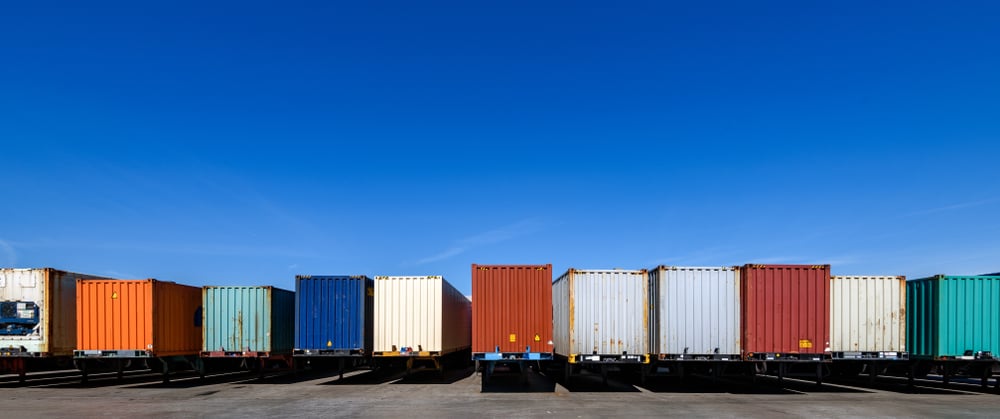The ultimate guide to Small Freight Shipping with ease and confidence
If you have a cargo shipment that you need to move by truck, but it’s not a huge shipment that could fill an entire cargo trailer, then a small freight option like partial truckload freight (PTL freight) or less-than-truckload freight (LTL freight) may be the right option for you.
Shipping LTL freight is quite different than simply sending something by mail, but once you’ve found the right carrier, the process is fairly straightforward. Here, we’ll go over how to ship small freight with ease and confidence.
Why small freight shipping is essential for modern businesses
Small freight shipping has become a critical component of today's supply chain ecosystem, enabling businesses of all sizes to move products efficiently without the commitment of full truckload shipments. This shipping method bridges the gap between traditional parcel services and large-scale freight operations, offering flexibility that modern commerce demands.
The evolution of small freight shipping reflects changing business models, particularly the rise of e-commerce and just-in-time manufacturing. Companies no longer need to maintain massive inventory levels or commit to full truckloads to move their products effectively. Small freight shipping allows businesses to respond quickly to market demands while maintaining cost-effective operations.
Key advantages of small freight shipping include:
- Reduced inventory holding costs through smaller, more frequent shipments.
- Improved cash flow by avoiding large upfront shipping commitments.
- Enhanced flexibility to serve diverse customer bases across multiple locations.
Small freight shipping particularly benefits businesses with seasonal fluctuations or those testing new markets. Instead of committing to full truckload quantities, companies can gauge market response with smaller shipments before scaling operations. This approach reduces risk while maintaining operational agility.
The technology revolution has made small freight shipping more accessible than ever. Digital platforms now provide instant access to carrier networks, transparent pricing, and real-time tracking capabilities that were previously available only to large-volume shippers. These technological advances have democratized freight shipping, enabling small and medium businesses to compete effectively with larger competitors.
For manufacturers, small freight shipping enables lean production strategies by supporting just-in-time delivery of components and finished goods. Retailers benefit from the ability to replenish inventory based on actual demand rather than forecasts, reducing waste and improving profitability.
As supply chains continue evolving toward greater flexibility and responsiveness, small freight shipping will remain essential for businesses seeking to optimize their logistics operations while maintaining competitive positioning in dynamic markets.
Shipping vs. Freight Shipping

Before you start looking at LTL freight shipping and start gathering your options, you need to first identify if your cargo can be shipped regularly or needs a freight option. If you have a parcel of up to 150 pounds, you can likely ship it via regular shipping with a shipping carrier like Fedex, UPS, or DHL.
But if you have a box or boxes over 150 pounds, then you need to find a freight carrier for your shipping needs. Depending on how much cargo you have, you will need to choose LTL or PTL shipping.
LTL freight shipping and PTL freight shipping

LTL and PTL freight shipping are similar but not identical. While both options are for shipments smaller than a full truckload, LTL carriers deal with cargo weighing between 150 and 20,000 pounds.
PTL freight carriers typically deal with cargo between 8,000 and 27,000 pounds. While there is an overlap, LTL shipments are generally smaller.
Here are some more key differences between LTL and PTL shipping.
|
LTL Shipping |
PTL Shipping |
|
Small shipments up to 20,000 pounds |
Larger shipments than LTL, but smaller than full truckload shipping- usually 6 to 20 pallets or weighing 8,000 to 27,000 pounds |
|
Less expensive than PTL |
More expensive than LTL due to the extra space and handling required for cargo |
|
Multiple shipments consolidated into one truck to fill space |
Uses a portion of a trailer’s space; remainder may be available for other shipments |
|
Longer transit time because there are several shipments in each load |
Shorter transit time because there are fewer stops and less handling |
|
Shipments are handled frequently at multiple points during transit |
Shipments are only handled at the beginning and end of the journey |
|
May be handled by multiple carriers to reach final destination |
Handled by a single carrier |
|
Offers more specialized services like lift-gate or inside delivery |
Fewer service options |
|
Requires freight class designations |
Does not require freight class designations |
|
Rates depend on published carrier rates |
Market-driven rates |
|
Requires pallets or crates |
Doesn’t always need pallets |
|
Requires freight liability |
Requires freight insurance |
For most individuals and many small businesses, LTL shipping will be the preferable option. Unless you have at least 8,000 pounds of cargo, PTL shipping may not even be available– and unless you have a lot of cargo, PTL is much less cost-effective than LTL.
In LTL shipping, multiple LTL freight shipments from different shippers are consolidated into one truck, sharing space and cost, which allows for a more cost-effective shipping option. You’re not just sharing space with other shippers; you’re sharing the financial burden, making LTL a good option for lots of budgets.

The best small freight shipping companies

You have a few options when looking for the best LTL freight shipping companies. Several carriers offer this as an option, including:
- FedEx Freight.
- YRC Freight/Yellow.
- XPO.
- Old Dominion.
- TForce Freight (formerly UPS Freight).
- Estes Express Line.
- ABF Freight/ArcBest.
- R+L Carriers.
- SAIA Inc.
- Southeastern Freight Lines.
- Averitt Express.
Technology solutions for small freight shipping
The small freight shipping landscape has been revolutionized by digital technology, giving shippers unprecedented control, visibility, and cost savings. Modern technology solutions have transformed how businesses approach LTL and PTL shipping, making the process more efficient and transparent than ever before.
Digital freight platforms vs. traditional brokers
Digital freight platforms are rapidly replacing traditional freight brokers for small shipment needs. While traditional brokers typically charge 15-25% markup on shipping costs, digital platforms often operate on transparent, flat-fee structures or lower percentage-based pricing.
Traditional broker limitations:
- Limited visibility into actual carrier rates.
- Lengthy quote processes requiring multiple phone calls.
- Inconsistent service quality across different representatives.
- Higher costs due to manual overhead and commission structures.
Digital platform advantages:
- Instant rate comparisons from multiple carriers.
- Transparent pricing with no hidden markups.
- Self-service booking available 24/7.
- Integrated documentation and tracking systems
. - Access to carrier reviews and performance ratings.
Platforms like Cargobot Pool streamline the entire LTL shipping process, allowing shippers to compare rates, book shipments, and manage documentation through a single interface. This eliminates the traditional back-and-forth negotiations while ensuring competitive pricing.

Real-time tracking and visibility tools
Modern small freight shipping demands real-time visibility, especially for temperature-sensitive or time-critical shipments. Advanced tracking solutions go beyond basic location updates to provide comprehensive shipment intelligence.
Enhanced tracking features:
- GPS location updates every 15-30 minutes.
- Temperature monitoring for refrigerated shipments.
- Delivery appointment scheduling and updates.
- Exception alerts for delays or route changes.
- Proof of delivery with electronic signatures and photos.
These tools are particularly valuable for LTL shipments, which traditionally had limited visibility due to multiple handling points. Real-time tracking helps shippers proactively manage customer expectations and quickly address any issues that arise during transit.
Mobile apps for managing small shipments
Mobile applications have become essential tools for managing small freight operations efficiently. Modern shipping apps allow complete shipment management from anywhere, making them ideal for small businesses without dedicated logistics staff.
Key mobile app capabilities:
- Instant rate quotes using smartphone cameras to capture dimensions.
- One-touch booking and carrier selection.
- Document upload and storage (BOLs, PODs, photos).
- Push notifications for delivery updates and exceptions.
- Integration with accounting systems for automated invoicing.
Mobile apps also enable better communication between shippers, carriers, and recipients. Features like in-app messaging, delivery scheduling, and real-time updates reduce phone calls and emails while improving overall shipping experience.
For small freight shippers, embracing these technology solutions isn't just about staying current—it's about gaining competitive advantages through improved efficiency, cost savings, and customer service capabilities.
Shipping small freight internationally
Not all freight companies will handle international deliveries, so a little extra legwork is required if you want to ship to Mexico or Canada. Fedex Freight has international LTL and PTL options, as does DHL. International freight shipping is more complicated in regards to paperwork, permits, and tariffs.
To reduce the hassle associated with finding a shipping company and arranging LTL or PTL shipping, you may want to consider an online option like GoShip or our own Cargobot Pool.
Our service makes small load shipping much easier and streamlines the process, making getting your cargo from Point A to Point B is cheaper and easier.
Small freight shipping cost

Determining how much your LTL freight shipping cost or PTL freight shipping cost will be is not easy to determine on your own. These shipping rates vary highly based on the market, what’s being shipped, and service options or logistical concerns.
You must determine your shipment’s freight class for LTL freight shipping. This standardized number shows how difficult your commodity is to ship and how much liability is involved in shipping.
It is determined by considering your shipment’s density, liability, handling, and how the shipment fits in the trailer with other freight. This is most easily done with a freight classification tool.
Your freight class will be a number between 50 and 500. The lower the number, the easier the cargo is to ship– which means the less expensive it will be.
How to ship small freight

Here are all the steps you need to take for successfully shipping LTL freight or PTL freight.
1) Check your carrier’s qualifications
When you choose a carrier, make sure they have experience with the type of cargo you’re shipping. Investigate their safety record, insurance coverage, and certifications.
Look for a carrier with a robust freight network that includes last-mile delivery and specialized lift-gate and other services; this will make it easier to ship to individuals or small businesses.
You should also ask your carrier about their equipment, such as temperature-controlled trailers and lift gates for fragile goods. If you’re shipping easy-spoil cargo like frozen food or refrigerated produce, you need to make sure that the company’s trucks can safely transport your goods.
2) Package your cargo
Once you’ve chosen a carrier or arranged for transportation through an online shipping service, it’s time to prepare your cargo. Proper packaging is essential for protecting your cargo during transport. Depending on whether you are doing LTL or PTL shipping, you may or may not need pallets and crates.
If your cargo needs to be kept cold, use insulated containers and packing materials like foam or polystyrene that can help maintain the desired temperature. You should also include temperature monitoring devices like data loggers and temperature indicators to ensure that the cargo stays within the required temperature range.
Make sure that each side of the packaging is clearly labeled with the temperature required and instructions to keep refrigerated or frozen.
For frozen cargo, include dry ice. Some carriers offer deep frozen shipping options for extremely temperature-sensitive shipments that use liquid nitrogen vapor, but for most frozen shipments, dry ice is sufficient.
If your cargo is fragile dry freight, use sturdy boxes or crates with bubble wrap, packing peanuts, excelsior, or other cushioning material.
Your shipping carrier should load these packages last to be unloaded first. For frozen and refrigerated shipments, this minimizes the amount of time they spend in a warming trailer. For fragile shipments, this reduces the risk of damage due to jostling during loading and transit.
Labeling is also important. Without proper labels, the risk of improper cargo handling increases. Labels should contain:
- Contents.
- Weight.
- Special instructions like “Keep Refrigerated” or “Fragile”.
- “Perishable” labels for perishable shipments.
3) Prepare your documentation
You must prepare all the necessary documentation, including the bill of lading, customs paperwork (if applicable), and any other permits or certificates required for shipping easy-spoil cargo.
Remember that if you’re shipping internationally, you will have more paperwork to complete. Agricultural products traveling internationally may require certificates of inspection.
4) Set up insurance
Cargo theft is on the rise, so having extra insurance for your shipment is a good idea. You have several different insurance options, many of which are offered directly through the carrier. Consult with your carrier about your insurance needs!
5) Timing and tracking
For easy-spoil cargo, you will want to plan your shipment timing carefully. Consider the transit time and the time to load and unload the freight. Remember that LTL cargo is handled more frequently than PTL cargo, and that LTL cargo deliveries stop more frequently than PTL deliveries.
For fragile dry freight, schedule the shipment during a time where there is less traffic and road congestion, and see if you can plan a route that avoids major interstate construction as much as possible.
Your carrier may offer tracking services, but if they don’t, GPS cargo tracking systems are readily available.
6) Communication
You will want to maintain communication with the carrier throughout the shipment. Stay in contact and be ready to provide additional instructions and information as needed.
You should also contact the recipient about any potential issues and delays. Follow up with them afterward to ensure they received the cargo in good condition.
Good communication is the best way to stop shipping problems before they start. Confirm details with the carrier and the recipient, and address any issues promptly before they escalate.
Ready to ship your small cargo? At CargoBot, we can help with all your shipping and shipping logistics needs, no matter how large or small your cargo load. Contact us today to get started with our innovative shipping solutions!

Common small freight shipping mistakes to avoid
Even experienced shippers can fall into costly traps when shipping small freight. Understanding these common pitfalls helps you avoid expensive delays, damage claims, and unexpected charges that can significantly impact your shipping operations and customer relationships.
Incorrect freight classification errors
Freight classification mistakes are among the most expensive errors in LTL shipping, often resulting in reclassification fees and billing adjustments. The National Motor Freight Traffic Association assigns freight classes from 50 to 500 based on density, handling, stowability, and liability. Many shippers make the critical error of using outdated commodity descriptions or miscalculating density by measuring packaging instead of actual freight dimensions.
Another frequent mistake involves choosing generic classifications instead of specific NMFC numbers. When product specifications change, shippers often forget to update their classifications accordingly. To prevent these errors, use official NMFC classification tools and measure shipments accurately, including all packaging materials. Document your classification methodology for consistency and consider reviewing classifications annually as products evolve.
Inadequate packaging that leads to damage claims
Poor packaging is responsible for the majority of freight damage claims in LTL shipping. Unlike FTL shipments where freight travels alone, LTL cargo shares trailer space with other shipments, increasing handling risks. Critical packaging requirements include using pallets rated for your shipment weight and ensuring packages don't overhang pallet edges. Secure items with appropriate stretch wrap and fill void spaces with cushioning material to prevent shifting.
Common packaging mistakes include using damaged pallets that can collapse during transit, inadequate stretch wrapping that allows packages to separate, and insufficient cushioning for fragile items. Poor weight distribution often causes pallets to become unstable, while missing labels for special handling requirements create confusion during transit.
Hidden fees and accessorial charges to watch for
| Service type | When required | Prevention strategy |
|---|---|---|
| Residential Delivery | Delivery to home addresses or non-commercial locations | Verify if delivery address is commercial with loading dock |
| Lift Gate Service | No loading dock available at pickup/delivery | Confirm dock availability before booking shipment |
| Inside Delivery | Freight must be moved inside building | Specify dock delivery only in shipping instructions |
| Appointment Delivery | Specific delivery time window required | Use standard delivery windows when possible |
| Redelivery | Failed first delivery attempt | Provide accurate contact info and delivery instructions |
| Limited Access | Delivery to schools, malls, construction sites | Identify location type during quote process |
| Detention | Driver waits beyond free time | Ensure recipient is ready for immediate unloading |
| Storage | Freight held at terminal beyond free days | Arrange prompt pickup after delivery notification |
Accessorial charges can significantly increase your shipping costs beyond the base freight rate. These fees cover services beyond standard dock-to-dock delivery. Common charges include residential delivery fees, lift gate service for locations without loading docks, and inside delivery when freight cannot be left at the dock. To minimize unexpected fees, request detailed quotes that include potential accessorial charges and verify delivery addresses to specify commercial versus residential locations.
FAQs about small freight shipping
1. What's the main difference between LTL and PTL shipping?
The primary difference lies in cargo weight and volume. LTL shipping handles freight between 150 and 20,000 pounds, while PTL focuses on larger shipments, typically between 8,000 and 27,000 pounds. LTL shipments are more economical but have longer transit times due to multiple stops and consolidation with other freight. PTL offers faster delivery times with less handling, but at a higher cost due to the additional space required in the trailer.
2. How do I determine the freight class for my LTL shipment?
Freight class is determined using four main factors: density, ease of handling, stowability, and liability. Density is calculated by dividing weight by the shipment's dimensions. You can use online freight classification tools or consult directly with your carrier. Classes range from 50 to 500, where lower numbers indicate easier-to-transport commodities and therefore more economical shipping costs.
3. What accessorial charges should I expect with small freight shipping?
The most common accessorial charges include residential delivery, lift gate service for locations without loading docks, inside delivery, appointment delivery, and redelivery for failed delivery attempts. You may also encounter charges for limited access locations like schools or malls, detention if the receiver isn't ready to unload, and storage if freight remains at the terminal beyond free time. To avoid surprises, always request detailed quotes that include potential accessorial charges.
4. When should I use a digital platform instead of a traditional broker?
Digital platforms are ideal when you need pricing transparency, quick rate comparisons, and direct control over your shipments. They're especially useful for regular shippers who want to develop direct relationships with carriers. Traditional brokers may be better for complex freight requiring specialized handling or when you need personalized guidance for international shipments. Digital platforms typically offer better pricing by eliminating intermediary markups.
5. What documentation do I need for international small freight shipping?
For international shipments, you need a bill of lading, complete customs documentation, and any specific permits based on your commodity type. Agricultural products require inspection certificates, while certain goods may need special licenses. You must also consider applicable tariffs and destination country regulations. Working with carriers experienced in international shipping is recommended to ensure compliance with all regulations and smooth customs clearance.
Read more about shipping your freight more efficiently this year:
- How to Choose the Best PTL Transport Solutions Partner
- 5 of the Biggest Headaches Facing PTL Shipping This Year
- 5 Ways Partial Truckload Companies Can Improve Their Supply Chain
- How PTL Shipping Companies Can Keep up with the Latest Technology Demands
- 5 Ways Refrigerated Trucking Companies Can Keep Up w/ Industry Demands
- Consolidated Freight Shipping: 5 Simple Hacks for Slashing Costs
- Faster Partial Truckload Shipping: Expert Tips for Stronger Operations

